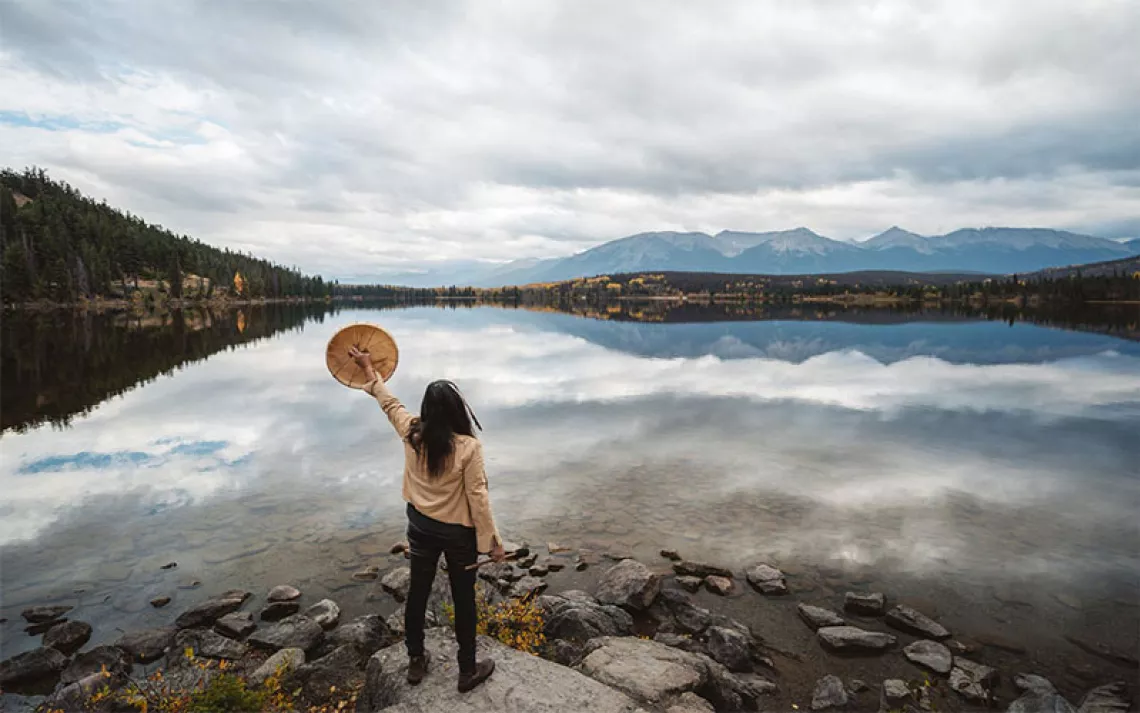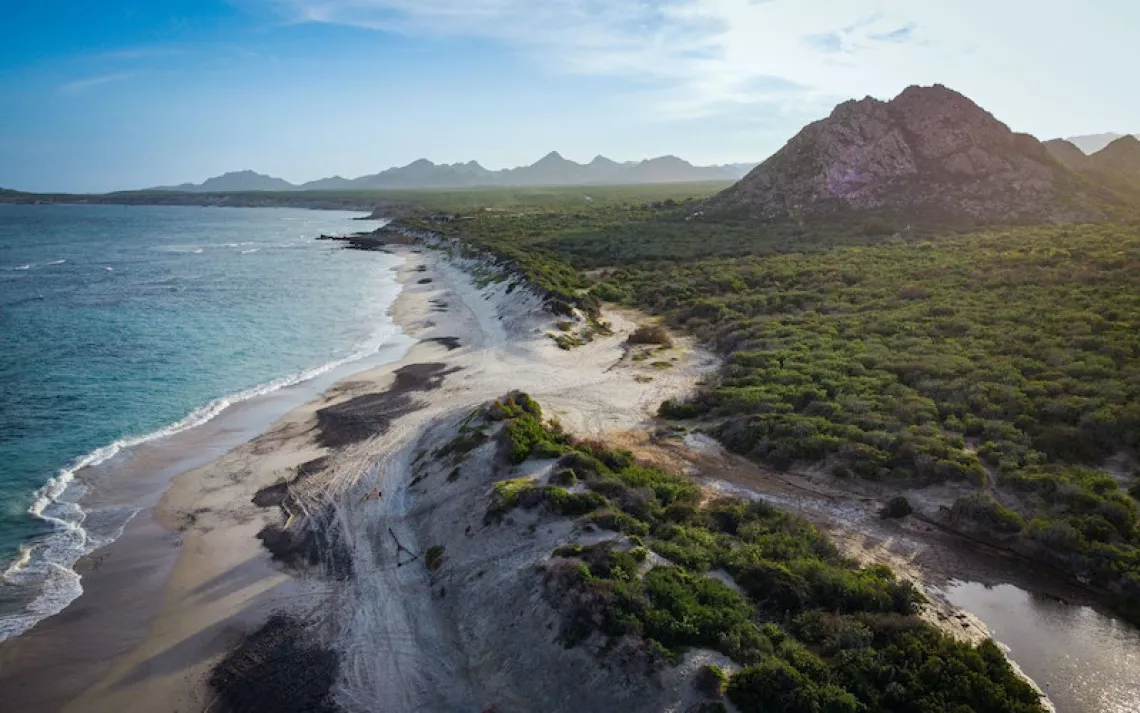Grass Roots
A Great Plains native finds his way home

Near the Nebraska-Colorado border, an early-summer High Plains mosaic stretches to the sky. | Photo by Michael Forsberg
On the summer afternoon I visited Lorenzo, Texas, the only people to be seen were the forklift operators, musicians, and farmers depicted in a mural celebrating the town's bygone days as a stop on the South Plains Railroad. Then Zane Reese arrived. Six feet tall, barrel-chested, he wore heavy work clothes despite the heat. Outside the Allsup's gas station, he shook my hand and said his name in such a way that a week later I found myself standing in front of a hotel mirror practicing introducing myself.
I was fresh out of college when I met Reese. Today, three years later, his voice blends with the voices of people I've since met in other grasslands, from Texas to the northern Great Plains to the Mongolian Steppe. Those voices remind me why I returned to a region I grew up wanting to leave, and why I spent so much time exploring a landscape most of the world long ago left behind.
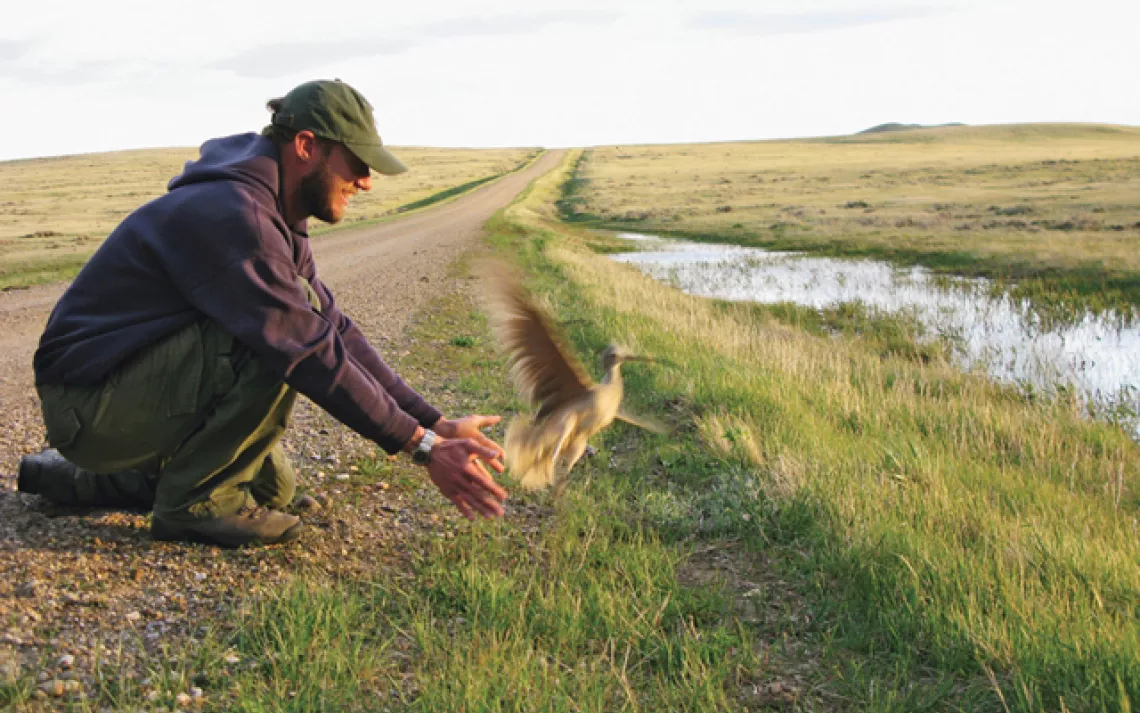
In Montana, Jorgensen releases a long-billed curlew that's been recently fitted with a transmitter. | Photo courtesy of Nils Warnock/Audubon Alaska
I was raised in Lubbock, 20 miles from Lorenzo. It's a place so flat that, as the saying goes, all you have to do to see farther than the next guy is stand on a can of tuna. Home to more than 200,000 people, it is huge for a Great Plains city, and when the wind isn't blowing and the air doesn't carry the smell of the feedlots, you almost forget where you are. But venture to the edge of town and the Plains are there, waiting.
Growing up, I came to love the simple beauty of the Plains. But I also thought of Lubbock as a place where nothing ever happened.
When I later began to read about the depopulation of the rural Great Plains, what surprised me wasn't that people were leaving the region but that it had once been bustling. When I was a child, it had never occurred to me that the empty houses decaying all over West Texas had once been homes. To think of the small towns near Lubbock smelling of fresh paint—the farmers coming in to dance on Saturday nights—lit in my mind a map that stretched all the way to Canada. I became more curious as I began to hear about people who envisioned a new future for the Plains.

The Land Institute's Ken Warren with deep-rooted grass. Right: The Great Plains stretch from Mexico to Canada. | Photo courtesy of Scott Bontz/The Land Institute; map by John Blanchard, source: Michael Forsberg's Great Plains
So I decided to take a road trip, and I didn't have to go far before the routes I traveled began to shrink. Interstates turned into U.S. highways. U.S. highways halved into farm-to-markets. Farm-to-markets faded into gravel. Soon, grasshoppers caked my windshield, and I found myself stopping frequently to investigate which hunk of metal had fallen off my car.
Lorenzo, population 1,372, was an island in a sea of blooming cotton when I went there to speak with Reese about farming. In his living room, a few blocks from the highway, he told me that his family had farmed in Mississippi, in Central Texas, in East Texas, and, for about 85 years, here in the Texas Panhandle.
Four years earlier, however, Reese's father, facing heavy debts, had sold off 6,000 acres. Reese was working as a roughneck in an oil field, and his daughter had just gone off to college.
"Sometimes I kind of miss farming and sometimes I don't," he told me. "If this house burned down or got blowed away, I'd be gone. There's no reason for me to stay here anymore. All the people I really liked are either dead or moved off."
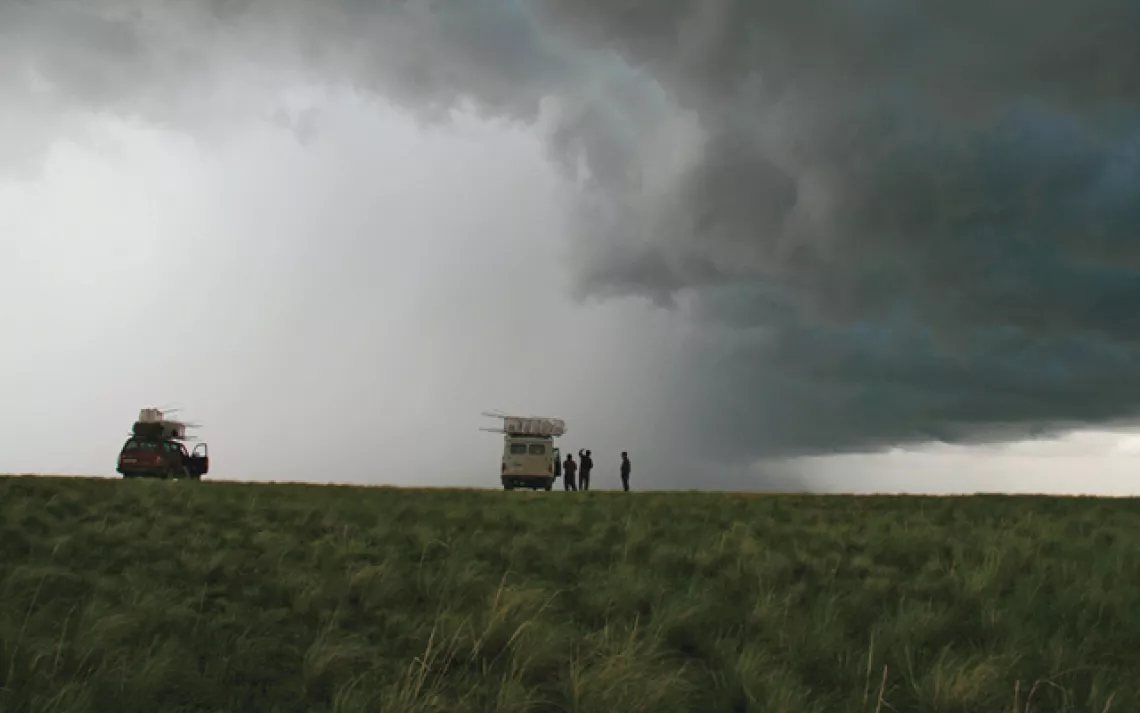
A serious thunderstorm approaches on Mongolia's Eastern Steppe. | Photo by Michael A. Parks
Reese's story wasn't a new one on the Great Plains. As far back as 1890—when the U.S. Census Bureau, responding to the apparent success of the 1862 Homestead Act, declared the frontier "closed"—the idea that farmers could tame the dry heart of the country was unraveling. The 1890s turned out to be the "Dry Nineties," and 184,000 settlers in Kansas alone fled their land.
Since then, the rural Plains have seen the "Dirty Thirties," the farm crisis of the eighties, and several periods of slower decline. Between 1950 and 2009, most Great Plains counties' populations declined. By 19th-century Census Bureau standards, some 400,000 square miles of the Plains—an area nearly half the size of the Louisiana Purchase—currently qualify as frontier.
The day after meeting Reese, I headed north from Lubbock. Before dawn, the sounds were of wind, creaking oil derricks, and a preacher on the radio. I passed towns with names like Shallowater, Nazareth, Earth, Cactus, Canyon, and Halfway, which wasn't. At the junction for Happy, I peered into a schoolhouse with waist-high grass growing in the doorway. In Liberal, Kansas, home of Dorothy and Toto, I saw a meatpacking plant the size of a university campus and a playground called Munchkin Land.
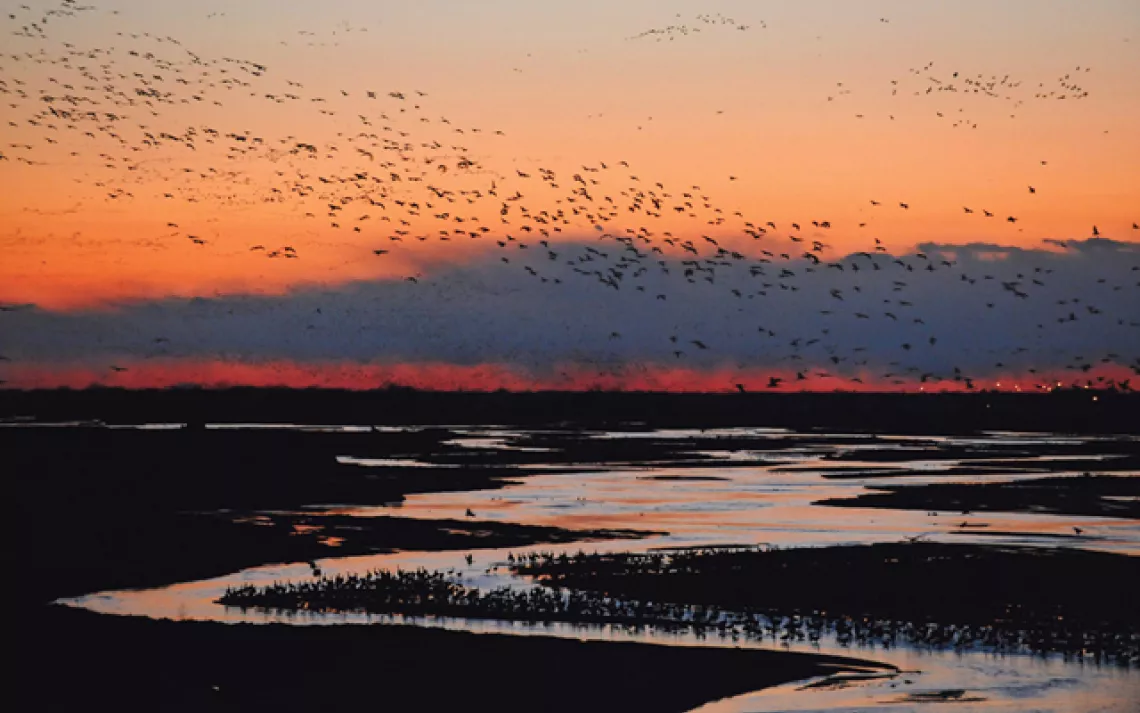
Every spring, hundreds of thousands of migrating sandhill cranes converge on a stretch of the Platte River in south-central Nebraska. | Photo by Michael Forsberg
Among the first serious grass men I met was Ken Warren. In his sixties, with straight white hair, Warren was a native Kansan who conversed with un-Kansan gusto. He'd completed graduate studies in biology and geology at Yale and Kansas State, and nothing excited him more than soil. Sometimes, when talking about aquifers or the "long, beautiful debate" about the origins of domesticated corn, he would lean forward in his chair, widen his eyes behind his glasses, and exclaim, "Wonderful!"
Warren was managing director of the Land Institute, outside Salina, Kansas, founded in 1976 by Wes and Dana Jackson. For 10,000 years, agriculture has consisted of annual plants grown in monocultures (think rice, wheat, corn). The Land Institute scientists were aiming to use the prairie as a model for an ambitious new kind of agriculture based on perennial polycultures. "If the plant scientists succeed," the editors of Scientific American wrote in 2007, "the achievement would rival humanity's original domestication of food crops . . . and be just as revolutionary."
In his office, Warren produced a poster-size version of the photo that had inspired me to visit him. On the left was annual wheat: raw bread. On the right was perennial wheatgrass, wheat's wild relative. Aboveground, the two plants looked nearly indistinguishable. Belowground, the annual wheat's roots were barely a wisp, while the wild wheat's roots dwarfed the upper portion. Thick and fantastic, the roots stretched down almost 10 feet.

From left: Kirk Olson, Jadambaa, Otgo, and Dondug. Right: A Mongolian gazelle. | Photo by Michael A. Parks
I liked the poster because of how much history it squeezed onto one page. Perennials aren't much good for consumption, because people eat seeds and perennials don't produce many. But unlike the annual crops settlers imported to the region, the perennials that once blanketed the Plains were adapted to the vicissitudes of the place.
The upshot, Warren explained, is that annual agriculture survives on the Plains only because of government subsidies, nitrogen fertilizers, pesticides, and groundwater irrigation. Each input comes with an environmental cost, and each makes it difficult for small-scale farmers to compete with larger operations.
The Land Institute's strategy has been to breed wild perennials in the direction of seed production, and domestic annuals in the direction of perennialism, with the goal of eventually producing deep-rooted, high-yield plants. The new perennial crops will build soil, conserve water, better sequester carbon dioxide, reduce pesticide use, and be more resilient to climate change.
"Imagine agriculture where all you need is soil, sunlight, and water," Warren said. "It sounds almost strange, doesn't it?" In the institute's greenhouse, Warren and I stood in front of a display of grassland plants, their roots tumbling to the ground. In the quiet of the afternoon, the collection reminded me of a diorama in a natural history museum. Yet Warren and I were trying to catch a glimpse of history running in reverse.
"Look," Warren said with boyish wonder. "Look at that."
By the time I left the Land Institute, I wanted to see grassland writ large. I had been infected by tales from the old days, when nomads roamed across continent-spanning ecosystems.

Bison graze among wind-sculpted cottonwoods in South Dakota's Cheyenne River Valley. | Photo by Michael Forsberg
But large expanses of grassland can be hard to find. Largely because of its suitability for agriculture, temperate grassland—a category including the Great Plains and the Eurasian Steppe, which stretches from Hungary almost to Manchuria—ranks as the world's most disturbed and least protected terrestrial biome.
Two years later, I found myself in a four-wheel-drive Russian van, rolling slowly across the world's largest remaining grassland. With me were two Mongols: driver Dondug and Jadambaa. In the Land Cruiser ahead of us, a Mongol named Otgo rode shotgun beside Kirk Olson, an American wildlife biologist.
After leaving Choibalsan, eastern Mongolia's largest city, three days earlier, the five of us bounced 300 off-road miles straight south to the Chinese border. Marked by two barbed wire fences of the sort common in the American West, it was the first barrier we encountered. Jadambaa took the opportunity to pee in the direction of China. Then we headed east, deeper into Mongolia's Eastern Steppe, an Oregon-size expanse at the edge of the Eurasian Steppe.
Encircled by environmental chaos, the Steppe was, and remains, a safe haven for birds on the Arctic-India flyway and home to more than 1 million migratory Mongolian gazelle. Sparsely populated even by Mongolian standards, the region is like an empty lot at the far reaches of the planet, where all the world's phone lines and roads, sidewalks and fences, terminate in a sea of grass.
Yet, as with most empty lots, developers have had designs on the Steppe. Long isolated by Mongolia's history of Khans and Communists, the Steppe has been open to the world since Mongolia transitioned to democracy in 1990, and it is now threatened by mining, oil drilling, agriculture, and the illegal wildlife trade. In 2006, the New York Times warned that continued overhunting could lead to an "extinction crisis" in Mongolia.
Olson, with an aquiline nose and neatly parted blond hair, responded to statements unsupported by fact with the glare of a Puritan preacher. Otherwise, he was patient and easygoing. He believed strongly in the old naturalist's maxim that the worst day in the field is better than the best day in the lab.
In the late 1990s, when Olson, who's fluent in Mongolian, first came here as a scientist for the Wildlife Conservation Society, little was known about the Steppe. So he began tracing enormous transects in his Land Cruiser, following longitudinal lines from the north of the territory to the south and back again. He estimated he'd logged 70,000 miles—which he claimed made him the "world record holder for longest distance driven slowly in straight lines." It allowed Olson to see more of the Steppe than anyone before.
A week into our trip we encountered 2,000 gazelle streaming down a hillside. Once, Olson might have guessed the animals were making a recurring seasonal move, like African wildebeest. But his travels, combined with GPS collar and satellite data parsed by colleagues in the United States, convinced him that their migrations were less predictable. This is a hard truth, because it means that protecting the gazelle requires more than setting aside chunks of habitat, Olson said.
The dilemma stemmed from the vagaries of the place. As with those of the Great Plains, Steppe temperatures range from more than 100 degrees Fahrenheit to minus 40, and come with droughts, deluges, dust storms, and prairie fires. Under such conditions, many animals move constantly in search of food. The beauty of the Steppe is also, from a conservation perspective, its curse: Temperate grasslands require and are defined by immense space. "In terms of biodiversity, you can't compare the Steppe with the rainforest," Olson said. "But this place is much more fragile. One fence can break the whole thing."
As we traveled, we experienced the land's variability firsthand. Head-high grass along dry riverbeds faded into expanses of onions and lilies followed by shrubby apricots. Lake regions, where great bustards ascended heavily and flocks of demoiselle cranes crossed the sky, rose to plateaus dotted with gazelle bones.
Some days the sky burned silver in the heat. I remembered reading about how settlers crossing the Great Plains would "hail as old friends" the trees they encountered.
One afternoon we headed east along a road built by an oil company. Low mountains rose in the distance and a blue demon floated by—an escaped party balloon from China. We turned north and the sky darkened as we passed into the shadow of a storm system. The thunder coalesced into a continuous roar.
That night, after the storm, we made out a single light on the horizon. It was the southern edge of a large oil field. Of all the pressures on the Steppe, Olson considered this expanding Chinese-run operation the biggest threat. "I got here the year they started surveying this," he said. "Where we are now used to be deep in the wilderness."
Over the course of our journey, Olson and I talked about the Steppe's uncertain future. Environmental groups such as the World Wildlife Fund, the Nature Conservancy, and the Wildlife Conservation Society were all at work in the region, promoting protected areas, training park rangers, and organizing grazing management groups.
But Olson wasn't optimistic. Under the status quo, he believed, development would continue and the Steppe would break into pieces.
"We're now collecting historical data, recording how this place was before it changes," Olson said one night, as we drove toward a sky lit by long, sideways veins of lightning. "We're on the backside of being too late."
The February after I returned from Mongolia, I set out again across the Great Plains. I headed north from Bismarck, North Dakota, on U.S. Highway 83, which cuts a straight line through the Plains, then west along the Hi-Line, with its black road, black trains, and blue ice. As night fell, I passed town after town without a motel, restaurant, or gas station. Snow gusted across the road. On the radio there was Indian drumming and singing, then an announcer: "Now the weather! Tomorrow, fog. Monday, fog and snow. Tuesday, OK. Wednesday, pretty good. Thursday, snow snow snow go away way way."
I was traveling to the site of the largest conservation project in North America. As the Plains have been emptying, people throughout the region have been trying to restore some of their natural grandeur. In Phillips County, Montana, the American Prairie Foundation, a land trust spun out of an idea proposed by the World Wildlife Fund, has been assembling a grassland reserve that could eventually encompass 3 million acres—one-third bigger than Yellowstone National Park.
In the morning, the road crossed an expanse of ice. Before the southern Plains had the Dust Bowl, the northern Plains had the winter of 1886—a.k.a. the Big Die Up, a.k.a. the Winter of Blue Snows—when severe weather following years of cattle overgrazing abruptly ended the era of the open range. Among the many who left was Teddy Roosevelt. Tumbledown homes peppering the landscape told the story of what's happened since. Phillips County was home to 9,311 people in 1920. As of 2009, its population was 3,944. Yet northeastern Montana's toughness makes it ideal for conservation efforts. Most of the land has never been plowed, and many abandoned parcels have reverted to Bureau of Land Management ownership. The American Prairie Foundation's plan is to cobble together its own land purchases with BLM grazing leases and connect its acreage to the 1.1 million-acre Charles M. Russell National Wildlife Refuge.
By noon, I arrived at the American Prairie Reserve, where I met Dennis Jorgensen, program manager for the World Wildlife Fund's Northern Great Plains Program, and Bryce Christensen. A native Nebraskan with a white mustache and fledgling handlebars, Christensen had spent 33 years with Montana Fish, Wildlife, and Parks before becoming the Prairie Foundation's manager of field operations. The three of us stood in the middle of a prairie dog town. In front of us was a seven-foot-high wind-screened, iron-barred fence. I couldn't help but think of King Kong.
I'd come at a good time. While North America is currently home to more than 500,000 American bison, decades of interbreeding with domestic cattle had left fewer than 20,000 animals free of cattle introgression. During its first five years of building a herd, the Prairie Foundation acquired and bred only 104 "purebreds." Then, a month before my visit, 94 baby bison from Elk Island National Park, Canada, arrived at the reserve.
We found the youngsters standing among bales of hay. As we approached, they wheeled away, then reversed direction, presenting a phalanx of horns. One began to bounce on four legs, like an enormous deer.
Watching the bison romp reminded me that they weren't cows but the largest wild animals native to North America. Once, the ecology of the continent shifted beneath their hooffalls. And the thought that they might roam again someday across a space big enough for all their thundering wildness filled me with hope for the prairie itself.
Thinking of the Winter of Blue Snows, I asked how the animals fare in Montana winters. Christensen and Jorgensen said the cold doesn't bother them at all. I picked a tuft of bison fur off the ground and clinched; my hand became uncomfortably hot. I asked whether they worried about bison trying to escape a blizzard and getting stuck against the smaller, electrified fences surrounding their pastures.
Christensen thought for a minute. "If they needed to leave, I think they'd just knock the fence over and go."
Back in Texas, I watch a perfect Great Plains afternoon blow away in a cloud of orange dirt. I'm visiting my favorite place on the Plains. I won't say where it is, because I don't want whoever installs Frisbee golf courses to get any ideas. Usually, the only shoeprints on the dusty, caliche-strewn road are my own.
If you throw a branch into the cattails in the canal here, hundreds of red-winged blackbirds shoot skyward. The kingfisher does anything to distract you from its nest. Big turtles sun themselves on logs. I've seen wild turkey and deer here too. The dry, curled buffalo grass makes a superb noise as you step from clump to clump. Like the rest of the Great Plains, it's an impure and beautiful place. And today cotton-field dirt blows ahead of a storm front. Half the Texas Panhandle is lofted over the city.
Canada geese fly backward. The first drops of muddy rain spatter around me. Elm branches trace wild circles.
I sit by the canal and think about the Great Plains and the Eurasian Steppe. The story of grass is at once a story of our impact on nature and of nature's resiliency. After more than a century of Homestead Acts, railroads, New Deals, tractors, wars, dust storms, Sharps buffalo rifles, and steel moldboard plows, the Great Plains still aren't settled. Like the Eurasian Steppe, the Plains remain a place where, in the long run, those who stay learn to change not the land but themselves.
I'm still not quite sure why I love the world's great grasslands as much as I do, but watching the storm come in, I realize it has a lot to do with the simple fact that they're huge. They stretch past the horizon, far beyond any plans we could ever make for them. I love their endless roads and their skies, which together form an irresistible invitation to daydream. And I love that the Plains will outlast us by a long shot.
 The Magazine of The Sierra Club
The Magazine of The Sierra Club

